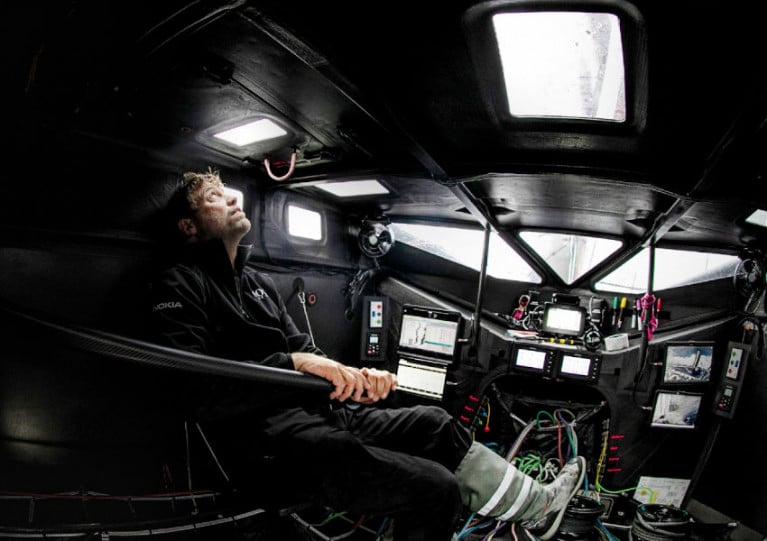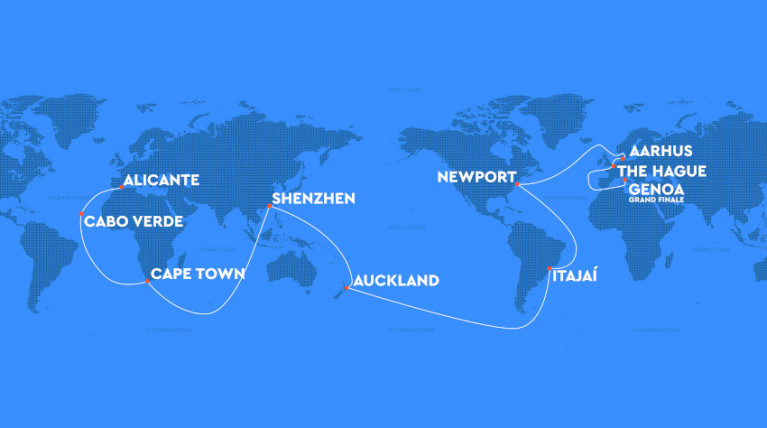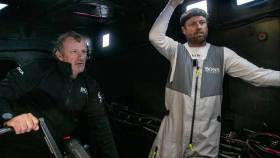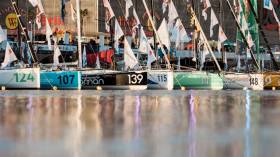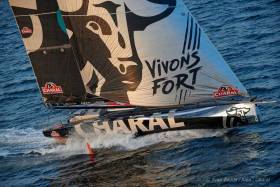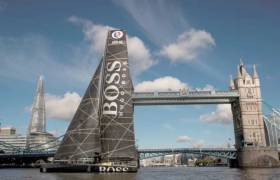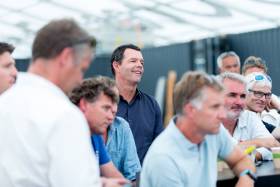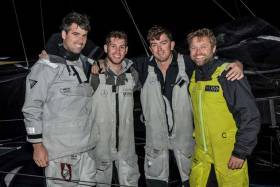Displaying items by tag: IMOCA 60
Damian Foxall Reveals New 'Sustainably Innovative' IMOCA 60
After 24 months of research, development, and construction, 11th Hour Racing Team has unveiled its new IMOCA 60, the first of a new era of boats designed to compete in fully crewed, short-handed and solo offshore sailboat races. There has been Irish input too, with County Kerry round the World sailor Damian Foxall, Sustainability Program Manager at 11th Hour Racing Team, providing a full 'Life Cycle assessment' over the course of the build.
A product of Guillaume Verdier’s design studio and built at CDK Technologies in the home of offshore yacht racing in Brittany, France, the new IMOCA 60 blends sporting performance with sustainable construction practices, and state-of-the-art boat building technology.
The hull was rolled out of CDK Technologies’ build shed in Port-la-Fôret, France on Saturday, August 7 and will head to MerConcept in Concarneau for its foils to be fitted along with other final touches. The boat’s colorful design, created in collaboration with two of Italy’s leading designers - Marco and Stefano Van Orton - and France’s Jean-Baptiste Epron - will be unveiled in full when the boat sails for the first time at the end of August.
Where IMOCA 60s are traditionally designed for the typical downwind course of the solo Vendée Globe, the 11th Hour Racing Team boat has been optimized for the broader range of conditions expected in The Ocean Race, which will cross the equator four times in the 2022-23 edition.
Featuring an entirely closed cockpit design, the new IMOCA 60 allows up to five sailors to live and work under the protection of its cover for the majority of time spent offshore. Thanks to its innovative shape, the cockpit provides near-360 degree visibility, further enhanced via a refined auto-pilot, navigation system, cameras, and marine mammal deterrence system.
 11th Hour Racing’s new IMOCA is rolled out of the shed at CDK Technologies in Port La Foret to see sunlight for the first time.
11th Hour Racing’s new IMOCA is rolled out of the shed at CDK Technologies in Port La Foret to see sunlight for the first time.
Also to be revealed in the coming weeks will be the culmination of two years - and several iterations - of foil design, tested both in the simulator and on the team’s first IMOCA 60, known as 11.1.
Striving to inspire action within the marine industry and beyond, the new 11th Hour Racing Team IMOCA 60 is seeking to set a benchmark for boat building innovations by utilizing alternative materials like flax for hatches, interior and deck panels, and implementing sustainable practices including stakeholder working groups and supply chain engagement, along with a highly analytical life cycle approach while supporting the creation of new IMOCA Class sustainability rules.
Skipper Charlie Enright was excited about the launch: “We’ve designed a version of the IMOCA 60 that no one has ever built before. Our boat should be able to withstand the toughest conditions in the most remote corners of the world, but is also able to compete in various shorthanded configurations. To build an all-around-performer like this, we have worked with the best in the trade: Guillaume Verdier as the lead naval architect, the technical and performance experts at MerConcept, and the build team at CDK Technologies. Running this project during a global pandemic was definitely a challenge, however, one constant never changed: putting sustainability at the center of the whole process.”
Damian Foxall, Sustainability Program Manager at 11th Hour Racing Team, explained more about this sustainability-first approach: “You can’t manage what you can’t measure - and what you can’t measure, can’t be improved. This is why we have executed a full Life Cycle Assessment over the course of the build process, in order to determine the environmental impact of the different components and procedures. Based on this evidence, we can work out different ways to reduce our impact, such as substituting highly-polluting materials with new alternatives, reducing single-use elements, optimizing our supply chain and internal operations, and refining the boat’s actual shape to make it more energy-efficient.
“Sharing our findings with the rest of the industry, from boat builders to sailors to race organizers, is an essential part of our mission, in order to inform the future and push the paradigm shift we urgently need. We have only 8 years left to meet the requirements of the Paris Agreement to reduce our impact by 50%. Business as usual is no longer an option.”
Durability has been a crucial factor in reducing the IMOCA 60’s overall footprint without compromising on performance and safety. Adaptable to both short-handed and fully-crewed racing, the boat in its current setup has been optimized to race with up to five sailors. The boat’s race schedule includes the upcoming Défi Azimut (raced double-handed with a non-sailing onboard media crew member), the Transat Jacques Vabre (double-handed), and The Ocean Race 2022-23 (four sailors and one sailing onboard media crew member).
“Winning The Ocean Race is our ultimate goal,” said Mark Towill, CEO of 11th Hour Racing Team. “These past months have been a huge collaborative effort, connecting a multitude of different stakeholders across the globe to build a boat that is completely different from what this Class has known so far. We are challenging the status quo and aiming to do it as sustainably as possible and sharing these learnings with the wider marine community. We are all extremely proud to see the boat leave the shed and are incredibly grateful to everyone for their hard work.”
Supported by sponsor 11th Hour Racing, the Team is looking to inspire other teams, race organizers and marine businesses to take action by starting their own sustainability journey. "The marine environment is harsher than any other, even outer space; the salt, wind, sun, and incredible force of water work to corrode, break down, or tear apart everything onboard," noted Jeremy Pochman, co-founder and CEO, 11th Hour Racing. "If the sustainable materials used in building the Team's new IMOCA can survive these conditions, then it's clear we can use such materials in less demanding boats, and the advances could ripple out through other industries that deal with far less harsh environments. This is a remarkable milestone as we work to change the narrative around sustainability in the marine and maritime industries, and in everyday life."
Leading up to the new boat’s naming ceremony scheduled for September 13, 11th Hour Racing Team will release a series of content features, including videos and photos, giving detailed insight into the new IMOCA 60’s unique design, artwork, and innovation processes.
The Vendée Globe will likely see a new record time set in the edition which starts this Sunday 8 November, with Hugo Boss skipper Alex Thomson suggesting a finish “between 59 and 70 days depending on the weather”.
Such a result would more the smash the 74 days it took Armel Le Cléac’h to round the globe in his IMOCA 60 Banque Populaire in the 2016-17 edition.
In the three years since that achievement, the Vendée Globe website says that IMOCA 60 package has improved in three crucial aspects: foils, data and skipper safety.
“The obvious evolution of foils is in their size,” Le Cléac’h says. “Four years ago we were just in the early stages of these new appendages. But the surface areas have changed a lot.
“In the end it is logical that, as with every Vendée Globe cycle, speeds increase and so everything progresses. Autopilots, data sensors and closed cockpits — everything is targeting at delivering or living with more speed.
“But at these speeds, the boats are transmitting big slams and shocks and the skippers have to adapt to this extreme level of discomfort.”
Aiding them in this respect will be the new fibre optic sensors installed on all boat elements that are under stress. These will transmit vital information to each skipper’s onboard data centre.
But perhaps the biggest difference is in the AI systems driving the boat’s autopilots, giving skippers more freedom to concentrate on the fine adjustments that could be the clincher for a new world record.
And in the case of Thomson and his array of screens that monitor every key part of his boat, that can all be done while being protected from the elements.
The Vendée Globe website has more on the story HERE.
The Ocean Race Reveals Complete Route For 2021-22 Edition
Amid the chaos surrounding event cancellations in the wake of the coronavirus threat, The Ocean Race has brought some much-needed certainty with the announcement of the full route for the 2021-22 edition of the prestigious round-the-world yacht race.
Starting in Alicante, Spain in October next year, the race will visit nine host ports around the globe — Cape Verde, Cape Town, Shenzhen, Auckland, Itajaí in Brazil, Newport in Rhode Island, Aarhus in Denmark, and The Hague — before its grand finale at Genoa in Italy in the summer of 2022.
Cape Verde, Shenzhen and Genoa have never before hosted the race, which for the first time is now open to the IMOCA 60 class in addition to its dedicated one-design VO65 that debuted in the 2017-18 edition of the then Volvo Ocean Race.
Confirming the “more compact” route, at a total of 38,000 nautical miles and with two fewer stopovers, “has taken on an added importance as the designers look to optimise performance for the conditions,” said Johan Salén, managing director of The Ocean Race.
Race chairman Richard Brisius added: “As ever, The Ocean Race appeals to athletes and teams who want to compete against the best in the world and add their name to the list of the legends of our sport who have defined their careers by taking on this incredible challenge.”
In the 2021-22 edition, this list will include more women as all race teams, in both classes, will be required to have female crew members.
And the introduction of the IMOCA 60 fleet presents a new opportunity for sailors to race in the world’s most challenging and competitive fully-crewed event.
Paul Meilhat, winner of the 2018 Route du Rhum and the current leader of the IMOCA sailor rankings, is among those looking to make the transition.
“It has long been my dream to compete in The Ocean Race and test myself against the best sailors in one of the most challenging races in the sport,” he said.
The Ocean Race organisers said they are “fully committed to holding a successful event” but, given the uncertainties related to the current coronavirus pandemic, they are in “ongoing conversations” with medical experts and authorities and following their advice.
“As always, the health, safety and well-being of The Ocean Race family and all race stakeholders is a top priority,” organisers said.
Hugo Boss Out of Transat Jaques Vabre With Keel Damage
British skippers Alex Thomson and Neal McDonald (Hugo Boss) are out of the Transat Jacques Vabre Race after hitting an object at sea this morning just a week into the offshore race.
The much-fancied British entry that has strong ties to Cork Harbour was 18th of the Imoca race to 484.84 nautical miles leaders Jérémie Beyou and Christopher Pratt (Charal).
Following the incident, Alex and Neal stopped the boat and carried out an inspection to assess the damage sustained. It became apparent that the keel is now only attached by the hydraulic ram.
The new yacht was launched in August as Afloat reported here.
Due to the damage sustained to the boat, the decision has been made that Alex and Neal will not continue on in the race.
The Alex Thomson Racing team is now working to assist the skippers to bring the boat to the nearest port.
Both Alex and Neal are currently safe inside the boat and did not sustain any major injuries.
#Offshore - A record 46 competitors have confirmed entry for the Transat Jacques Vabre 2019 with seven months yet to go till the start.
The numbers are already close to what organisers expected in January would be the full fleet to set out from Le Havre for Brazil this October — and entries are still open for another 12 weeks till Friday 12 July.
Despite promises that the previous race would stage a new dawn for multihulls like the Multi 50, much of the fleet will comprise IMOCA 60s but there will also be a sizeable contingent of Class 40s.
“The double-handed race allows well-prepared and seasoned amateurs to mix and measure themselves against the most recognised professional skippers,” says Class 40 president Halvard Mabire.
Giant IMOCA 60 Turnout for 2019 Fastnet Race
One of the largest fleets of IMOCA 60s ever gathered is due to set off on the Rolex Fastnet Race on Saturday, 3rd August. 29 of the boats, best known for their use in the Vendée Globe singlehanded non-stop round the world race, will assemble on the Cowes start line of the Royal Ocean Racing Club's premier event to take part in the biennial voyage to Plymouth via the Fastnet Rock - 26 competing in the IMOCA class, another three in the main IRC fleet.
This line-up is the third biggest in IMOCA history, after the 2016-17 and 2008-09 Vendée Globes, and is due to the Rolex Fastnet Race being a qualifier for the next Vendée Globe.
"However," adds Antoine Mermod, President of IMOCA, "the race means a lot and is important to French sailors because it is so historic. It also has a very nice course."
The IMOCA class is also now under the microscope internationally after its selection as one of the two classes for the next Ocean Race (ex-Volvo Ocean Race).
Newer IMOCA 60s incorporate the latest foiling technology. This has transformed their performance, reducing displacement and drag thanks to their foils partly, or at times fully, elevating them from the water. Since the last Vendée Globe in 2016-17 when this technology featured on a few top boats, second-generation foils are being fitted to the latest launches.
"At the best angle and boat speed the foils give a 15% jump in performance - it's huge," explains Mermod. "You sail at 13 knots and then when you start foiling the speed jumps to 18. You never do 15 knots!"
Eight new foilers are set to be on the start line of next year's Vendée Globe. Two are currently entered in the Rolex Fastnet Race - Jérémie Beyou's Charal, launched last year, and Sebastien Simon's Arkea-Paprec, a brand new design from Juan Kouyoumdjian, launching this June. Simon, the winner of last year's La Solitaire URGO Le Figaro, will be sailing with 2004-05 Vendée Globe winner Vincent Riou, who also won the Rolex Fastnet Race in 2015 aboard PRB. (PRB is also competing, but with new skipper Kevin Escoffier, who sailed Dongfeng Racing Team to victory in the last Volvo Ocean Race, alongside Jérémie Beyou).
Among the older foil-assisted boats are Bureau Vallée 2, formerly the 2016 Vendée Globe winner Banque Populaire, now skippered by Louis Burton. German skipper Boris Herrmann returns with Malizia (ex-Edmond de Rothschild), which he sailed to third place in the last Rolex Fastnet Race. Italian ex-Mini sailor Giancarlo Pedote has acquired the former St Michel Virbac previously campaigned by Jean-Pierre Dick and Yann Eliès.
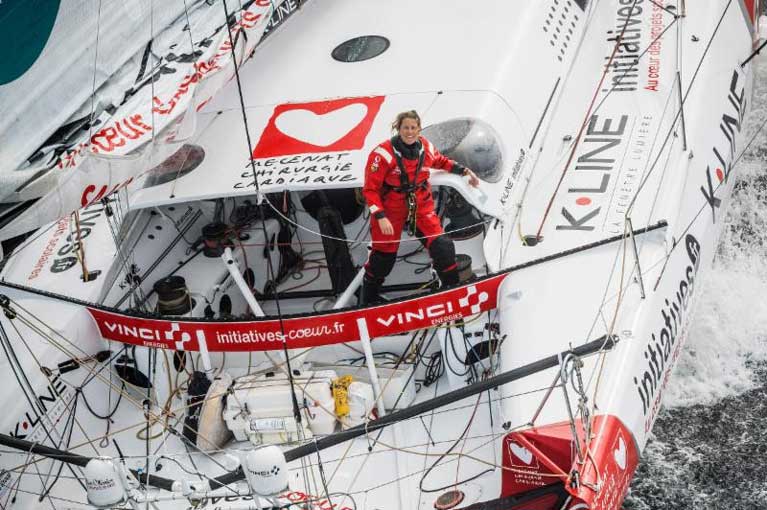 Sam Davies will compete with past winner Paul Meilhat on Initiatives Coeur © Vincent Curutchet / Initiatives Coeur
Sam Davies will compete with past winner Paul Meilhat on Initiatives Coeur © Vincent Curutchet / Initiatives Coeur
Britain's Sam Davies is back on Initiatives Coeur (originally Michel Desjoyeaux's 2008-9 Vendée Globe winner Foncia), having taken over this campaign from Tanguy de Lamotte, with whom she claimed fourth place in the last Rolex Fastnet Race. This time Davies is sailing with Paul Meilhat, winner of last year's Route du Rhum and the last Rolex Fastnet Race.
With the next Vendée Globe now 18 months away, many skippers have acquired boats that are new to them and are using this season to get acquainted.
Having sold their 2016-17 Vendée Globe winning IMOCA 60 to Louis Burton, Banque Populaire is back in the class having acquired the former MACIF/SMA, originally Francois Gabart's 2012-13 Vendée Globe winner. For their latest programme they have recruited 29-year-old Clarisse Crémer, following her second place in the 2017 Mini-Transat La Boulangère's Series class. On board for the Fastnet race with Crémer will be the team's principal skipper, 2016-17 Vendée Globe winner Armel le Cleac'h, as he awaits the launch of his new replacement Ultime maxi-trimaran.
One of the most impressive aspects of the Rolex Fastnet Race's mighty IMOCA line-up are the seven female skippers, three British. In addition to Sam Davies is former Mini sailor Pip Hare, who has acquired Superbigou, the boat on which Swiss skipper Bernard Stamm won the 2002-3 Around Alone and subsequent 2006-7 Velux 5 Oceans solo round the world races.
Miranda Merron makes a welcome return to the IMOCA 60 after a long tenure in the Class40 with her latest Campagne de France - the former Temenos/Great American IV. Of the Rolex Fastnet Race she says: "I have been around the Fastnet Rock countless times in the RORC's races or otherwise, but it is still the same mythical place with the amazing lighthouse. It is always a pleasure to round it." She is racing with her partner and IMOCA coach, French offshore sailing legend Halvard Mabire.
Other female skippers competing are Ireland's Joan Mulloy, on Mike Golding's former Gamesa, France's Alexia Barrier on 4myplanet and Franco-German skipper Isabelle Joschke on MACSF.
While it is not yet as internationally diverse as the Class40, still ten different countries are represented including two from Scandinavia: Norway's Oliver Korte on Galactic Viking (ex-Solidaire) in the IRC fleet and Finland's Ari Huusela on Ariel 2 (previously Dee Caffari's Aviva/GAES).
Eleven of the last Vendée Globe's 29 skippers (albeit only five finishers) will be racing in this year's Rolex Fastnet Race. Since that race several have graduated up: Swiss skipper Alan Roura (who sailed Pip Hare's boat to 12th place) now has Marc Guillemot's Safran while French skipper Fabrice Amedeo, who came home 11th, has acquired Pieter Heerema's No Way Back, a first generation foiler from the last race, rechristened Newrest - Art & Fenêtres.
As a genre IMOCA 60s date back to the early 1980s when it evolved in singlehanded oceanic races such as the BOC Challenge and OSTAR, however their development accelerated once they were adopted for the first Vendée Globe in 1989. A piece of IMOCA history is taking part in this year's Rolex Fastnet Race in the IRC fleet, with Jean-Marie Patier's Le Cigare Rouge, the narrow lightweight yawl that was runner-up in the second Vendée Globe in the hands of Jean-Luc van den Heede, winner of the recent Golden Globe Race.
Several boats are entered from the 2000 Vendée Globe, the race in which Dame Ellen MacArthur memorably fought Michel Desjoyeaux for the lead all the way up the Atlantic. Most notable of these is Alexia Barrier's 4myplanet, which in the hands of original owner Catherine Chabaud, won the Fastnet Challenge Cup outright under handicap 20 years ago.
For more information go to the Rolex Fastnet Race minisite here
Thomson Sets New Monohull Speed Record On Hugo Boss
British offshore skipper Alex Thomson and his crew sailing the IMOCA 60 Hugo Boss have officially broken the 24-hour distance record for a 60ft monohull, as Sail-World reports.
Thomson — who sailed with fellow 2020 Vendée Globe challenger Nin O’Leary on Hugo Boss last year — raced 539.71 nautical miles over the course of 24 hours, breaking his own extant record set last year by 2.9nm.
The new record was ratified last week after the feat achieved on 19-20 July during a transatlantic crossing from New York to the UK. Sail-World has more on the story HERE.
#VOR - The Volvo Ocean Race has announced its partnership agreement with the International Monohull Open Class Association (IMOCA), which provides the exclusivity to use the IMOCA 60 for crewed round the world yacht races.
Last week, during the finish of the Volvo Ocean Race in The Hague, an educational session for interested parties was held around the IMOCA Class Rules.
Sailors from the most recent Volvo Ocean Race and IMOCA events, along with yacht designers currently involved in construction of new IMOCA Class boats such as Guillaume Verdier and Juan Kouyoumdjian, came to The Hague to brainstorm around the changes.
“This is a first step of many in preparing for the next edition of the race in 2021,” said Johan Salen, co-president of the race. “There is an ongoing co-operation process to put in place the elements we need to make the next race a success from a sporting and business point of view.
“This is a complex matter with many perspectives, and we are respectfully welcoming continuous input from all key stakeholders, from World Sailing to individual sailors, teams and partners. We are confident that this is the right way forward.
“Moving the race into foiling monohulls under the IMOCA class will motivate more sailors, teams and the wider marine industry to prepare for the next edition. Partnering with the existing IMOCA infrastructure means the professional offshore sailing calendar becomes more unified and efficient, this helps the sport as a whole and helps to build a sustainable business model for teams and sailors.”
“This agreement provides IMOCA owners and sailors with access to the premiere fully crewed offshore race in the world, which is also a great storytelling platform,” said Antoine Mermod, president of IMOCA.
“As we work together to bring the most important offshore races in the world – short-handed and fully crewed – to the IMOCA class boats, it will allow us to grow the class internationally and offer more value to our stakeholders.”
 Rendering of a possible future design for the race
Rendering of a possible future design for the race
The move to include IMOCA boats has been made in an effort to ensure the race continues at the forefront of yacht design and technology while challenging the best sailors in the world in a fully crewed, offshore environment.
A joint committee is being formed to draft a specific section of the Class Rules for Crewed IMOCA 60, respecting the spirit and intent of the partnership, which includes cost control, security and sporting fairness.
The rule relating to crew numbers on board the IMOCA class in the next race is among the items under consideration, with the goal of retaining an On Board Reporter role.
The latest Volvo Ocean Race concluded this past weekend having seen the closest racing in the 45-year history of the event.
Three teams started the final leg with an opportunity to win the overall race title. With less than 10 miles left in the 45,000 nautical mile, 11-leg race, the outcome was still in doubt until Charles Caudrelier’s Dongfeng Race Team finally slipped ahead of their rivals to secure a thrilling victory off The Hague.
“This change is very exciting,” Caudrelier said after receiving a briefing on the changes. “The Open 60s are just amazing boats. I really enjoy sailing on these boats and I think when people see it, they will enjoy it. If the two best offshore races in the world are going to join the same class, to me it’s good news.”
“I think as a sailor, this is very exciting,” said Bouwe Bekking, a veteran of eight Volvo Ocean and Whitbread Round the World races. “For the younger generation of sailors, they’re all about foiling and surfing and going fast and you have to get the best sailors involved in the race. With the Open 60s, they’ve nailed it, because this is what the sailors want.”
“Of course there are some hurdles to negotiate,” said Torben Grael, Olympic champion and a Volvo Ocean Race winning skipper as well as a vice-president of World Sailing.
“But if we manage to join the two worlds together then it will be positive as it opens the race to many new sailors to join and creates a much bigger calendar of events for the teams racing in Open 60s.”
The partnership means the leading designers in offshore sailing will be engaged in the next edition of the race with the goal of producing the fastest fully-crewed offshore round the world racing monohull in history.
“Yachting is a sport that isn’t only about the crew, but it’s also about the equipment, so combining the two elements is what allows you to say you are at the pinnacle of offshore racing,” said Juan Kouyoumdjian, who has designed three Volvo Ocean Race-winning boats in the past.
“I think it is a very positive step forward. The future will allow for the sailors and designers to push to the next level which will inevitably trickle down to other classes.”
“We’re trying to make a boat for the future that is capable of doing both short-handed and fully-crewed races,” said Guillaume Verdier, among of the busiest of the current IMOCA class and America’s Cup designers. “My opinion is that it is doable with a bit of compromise from both worlds to meet in the middle.”
The partnership with IMOCA will also ensure that the boats will allow for the production of cutting-edge media, as was the case on the current edition of the Volvo Ocean Race.
Live access to the boats while they were racing in some of the most remote oceans of the world, as well as drone footage and media produced by on-board reporters made for ground-breaking coverage that produced record fan engagement.
This remains an important priority for the next race, as does crew diversity. The 2017-18 Volvo Ocean Race featured 23 female sailors as well as 30 sailors under the age of 30. Both were records for the race. This is a trend to be encouraged for the future, race organisers insist.
“The process is just starting,” said Nick Bice, who is leading the project to develop the Open 60 rule for the next race. “We’ve had four of the current IMOCA designers with us to help us understand the issues we’re going to face.
“We’ll forward everyone’s input to the joint committee and get started on developing the rules that will be used for Open 60s to participate in the next race. Our goal is to have this ready to go by the end of the year.”
The future of the VO65 class of boats, used in the last two editions of the race, will be revealed in the coming weeks.
Royal Cork's Nin O’Leary Shares Hugo Boss’s Success in Middle Sea Race
George David’s Rambler 88 has taken line honours for the owner’s third time in the 608-mile Rolex Middle Sea Race currently finishing in Valetta writes W M Nixon. But Nin O’Leary and Alex Thomson in the IMOCA 60 Hugo Boss have turned in a virtuoso offshore performance to be third home across the line, bested only by the significantly larger Rambler and the 100ft Leopard.
Unlike the Fastnet Race 2017, where Hugo Boss suffered from having to beat the whole way from Cowes to the Fastnet Rock, thereby leaving inadequate space and distance to demonstrate her formidable offwind capacity, in this race the “lovely black boat” was able to lay the course – albeit in often very light winds – most of the way on the anti-clockwise circuit towards the most northerly turning point, the volcanic island of Stromboli.
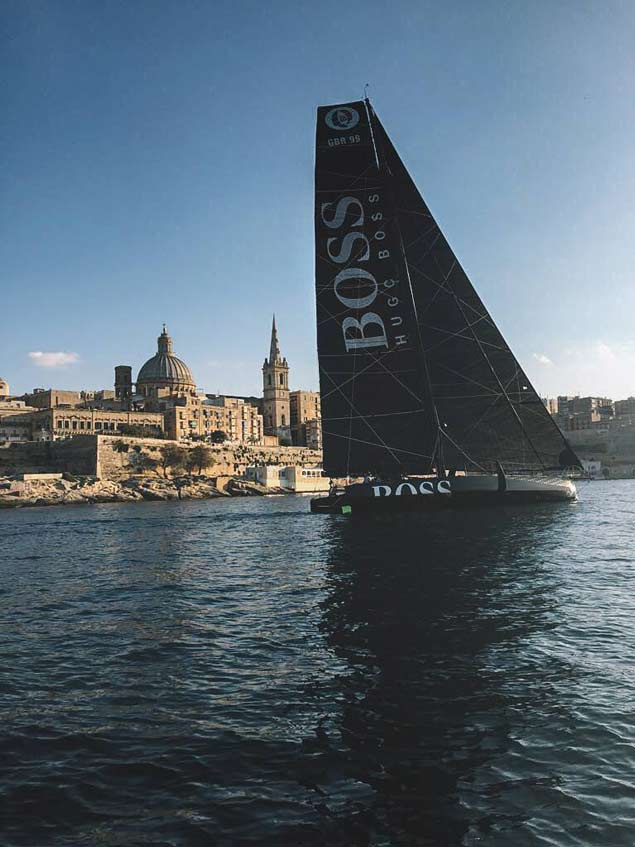 Hugo Boss gets smoothly away from Valetta at the start. Although winds were light all the way to the northerly turn at Stromboli, they were seldom dead on the nose and the specialised IMOC 60 was able to stay well placed. Photo: Kurt Arrigo
Hugo Boss gets smoothly away from Valetta at the start. Although winds were light all the way to the northerly turn at Stromboli, they were seldom dead on the nose and the specialised IMOC 60 was able to stay well placed. Photo: Kurt Arrigo
There, with a west to nor’westerly filling in to eventually become a classic Mistral-generated Mediterranean gale, most of the fleet elected for long tack/short tack progress towards Sicliy’s decidedly rugged northwestly coast’s series of massive headlands. But Hugo Boss’s crew chose to continue to lay on port tack far offshore, accepting the reality that right-on windward work is not their boat’s strong suit.
Thus they found both a slightly more favourable slant of wind well offshore, and a more regular sea state. The northwest corner of Sciliy is notorious for its confused back-wash ridden sea, and when Hugo Boss closed with the fleet again yesterday morning, they were already approaching Sicily’s most westerly race turn at Favignana island, finding themselves in company with the larger boats, and now well ahead of 50ft to 65ft craft which had been hassling them earlier in the race.
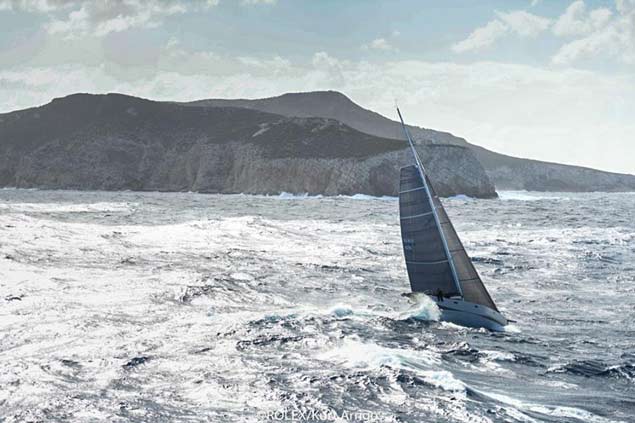 The Botin 65 Caro (Maximilian Klink, Germany) kicks her heels in heavy winds in the backwash-plagued rough seas off Sicily’s northwest coast. Boats that gave much of this coast a good offing, such as XP-ACT and particularly Hugo Boss, benefitted from more regular seas Photo: Kurt Arrigo
The Botin 65 Caro (Maximilian Klink, Germany) kicks her heels in heavy winds in the backwash-plagued rough seas off Sicily’s northwest coast. Boats that gave much of this coast a good offing, such as XP-ACT and particularly Hugo Boss, benefitted from more regular seas Photo: Kurt Arrigo
With Favignana astern, it was all systems go, and at the front of the fleet while Rambler 88 – which was to cover the final 300 miles in 14 hours – was unassailable, for a while Hugo Boss looked as though she might be able to pip Leopard for second place on the water.
It was not to be, as things were easing slightly as the leaders came into Valetta late last night and in the small hours of this morning. With the pace dropping. Rambler 88 was able both to finish first and beat Hugo Boss on corrected time, albeit by just 5 minutes and 26 seconds. But O’Leary and Thompson and their crew of Will Jackson and Jack Trigger (there’s only room for two extra on the very purpose-designed IMOCA 60) were able to beat Leopard (Pascal Oddo, France) by 55 minutes on CT, while Udde Ingvall’s super-skinny Maxi 98 CQS from Australia has finished fourth across the line, almost ten hours astern of Hugo Boss on corrected time.
The severe conditions north of Sicily have taken their toll of the fleet and Irish entries, with Two-Handed favourites Brian Flahive of Wicklow and Sean Arrigo of Malta with the J/122 Otra Vez an early retiral, while Conor Doyle of Kinsale with the DK 46 Hydra had managed to get as far as the great headlands of northwest Sicily before pulling out.
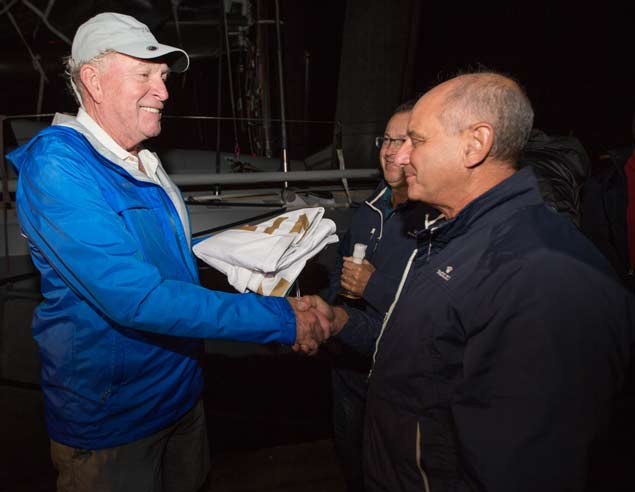 He’s done it again. George David (left) receives the line honours flag for the third time from Royal Malta YC Commodore Godwin Zammit
He’s done it again. George David (left) receives the line honours flag for the third time from Royal Malta YC Commodore Godwin Zammit
But Ireland’s most experienced participant, Middle Sea Race 14-times veteran2012 Barry Hurley, is sailing a really cool race with Shane Giviney and other noted talents on the Xp44 XP-ACT. Having given those bouncy northwestern headlands a decent offing to get them quickly clear while maintaining a good fleet place, they’ve just passed Pantellaria and are lying fourth overall on corrected time.
Current handicap leader is the 2012 Swan 53 Music (James Blackmore, South Africa) while the Russian JPK 10.80 Bogatyr (Igor Rytov) is second and the former Round Ireland star Tonnere de Breskens, the Ker 46 now known as Tonnere de Glen and owned by Tian Domonique of France, is third, with XP-ACT in fourth overall and well clear of the next boat.
Speeds are still well up, but with the wind easing it’s going to be a long day getting past Lampedusa and across to the finish at Valetta.
Race tracker here
New Volvo Ocean Race Design Is Taking Shape
#VOR - Just over three months ago, the Volvo Ocean Race unveiled the new generation of boats for the next decade and beyond, as previously reported on Afloat.ie.
In its answer to the big question ‘monohull or multihull?’, the VOR opted for both: a one-design foil-assisted 60ft monohull for the ocean legs, and a one-design 32-50ft foiling catamaran for use inshore at the stopovers.
Now, with the 2017-18 edition already apace following a thrilling Leg Zero, work on the two new boats has been moving fast in the background, as the VOR website reports.
Last week, the first mock up of the Guillaume Verdier-designed offshore monohull was revealed at the Boatyard in Lisbon.
“We contacted several designers and asked them to submit their ideas for both a complete stand-alone Volvo Ocean Race boat, or with the potential to convert to an IMOCA boat,” said Boatyard head Nick Bice.
“All the designers that we invited to present were very strong, it wasn’t clear cut – we had some pretty serious soul-searching to decide what we wanted to do. I went to New Zealand and spent a day with Guillaume to get to know him, and we decided he was our man.”
Verdier is best known as a designer for the foiling 2016 Vendée Globe boats, and for the 35th America’s Cup winners Emirates Team New Zealand.
“We’ve created the Volvo Ocean Race Design Team as a collaboration, getting the best input from everywhere,” said Bice. “It’s going to be a very cool boat; imagine coming into the finish, in a harbour in 20 knots of breeze and you are going to see this thing fully airborne, foiling, at 35 to 40 knots.”
Verdier's team is already working hard on the hull lines. The design has developed in a way that will enable IMOCA 60 compatibility, making it convertible for events like the Vendée Globe.
And they’ve got not time to lose, with Bice emphasising the “critical path” till the scheduled launch in June 2019.
“Working all the way back from that, we need to start machining the moulds in September. Then we need to start laminating the first boat at the end of February, early March next year,” says Bice, who adds that Persico Marine in Italy is the lead contractor for the ambitious project.
As for the inshore foiling multihull, the tender period closed on Monday 31 July with 16 proposals received. Now Bice, as chief technical development officer, and his team must make their decision in view to an announcement during pre-race events in Alicante this October.
The VOR website has more on the story HERE.



























